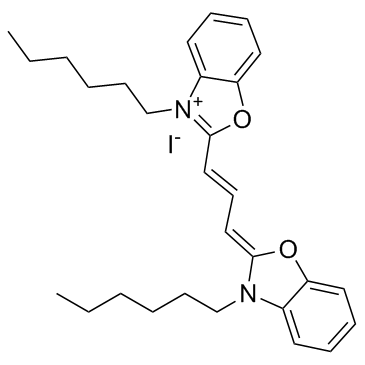3,3'-Dihexyloxacarbocyanine iodide (DiOC6(3) iodide) (Synonyms: DiOC6(3), NK 2280) |
| カタログ番号GC33493 |
3,3'-ヨウ化ジヘキシルオキサカルボシアニン (DiOC6(3) ヨウ化物) は、ミトコンドリア膜電位の変化を監視するために使用できるカルボシアニン色素です。
Products are for research use only. Not for human use. We do not sell to patients.

Cas No.: 53213-82-4
Sample solution is provided at 25 µL, 10mM.
3,3'-Dihexyloxacarbocyanine iodide is a carbocyanine dye which can be used to monitor changes in mitochondrial membrane potential.
Addition of cells to the cuvette containing 0.25 μM 3,3'-Dihexyloxacarbocyanine iodide (DiOCg(3)) leads to an increase in fluorescence, equilibration is rapid and is complete by 4 min. When f-met-leu-phe (10-7 M) is added to neutrophils preequilibrated with 3,3'-Dihexyloxacarbocyanine iodide, there is a short lag period of 5 seconds. The lag period is followed by a rapid loss of fluorescence. Examination of 3,3'-Dihexyloxacarbocyanine iodide loaded neutrophils using fluorescence microscopy demonstrates that in resting neutrophils the brightest fluorescence is associated with long thin organelles which corresponds to the distribution of mitochondria[1].
[1]. Korchak HM, et al. A carbocyanine dye, DiOC6(3), acts as a mitochondrial probe in human neutrophils. Biochem Biophys Res Commun. 1982 Oct 29;108(4):1495-501.
Average Rating: 5 (Based on Reviews and 34 reference(s) in Google Scholar.)
GLPBIO products are for RESEARCH USE ONLY. Please make sure your review or question is research based.
Required fields are marked with *




















